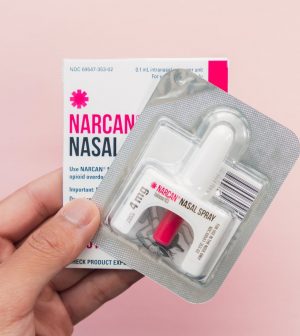- Navigating Your Midlife Crisis: Embracing New Possibilities
- City Raccoons Showing Signs of Domestication
- Mapping the Exposome: Science Broadens Focus to Environmental Disease Triggers
- One Week Less on Social Media Linked to Better Mental Health
- Your Brain Changes in Stages as You Age, Study Finds
- Some Suicide Victims Show No Typical Warning Signs, Study Finds
- ByHeart Formula Faces Lawsuits After Babies Sickened With Botulism
- Switch to Vegan Diet Could Cut Your Greenhouse Gas Emissions in Half
- Regular Bedtime Does Wonders for Blood Pressure
- Dining Alone Could Mean Worse Nutrition for Seniors
High Out-of-Pocket Costs Keep Some From Lifesaving Opioid Antidote

Patients are less likely to fill prescriptions for the overdose-reversing drug naloxone when they have to shell out more at the pharmacy, a new study finds.
Naloxone (also known by the brand name Narcan) is a critical lifesaving tool in preventing deaths from opioid overdose, researchers said.
But about 1 in 3 naloxone prescriptions for privately insured and Medicare patients went unfilled between November 2020 and March 2021, according to a national pharmacy database.
The rate of non-filled naloxone prescriptions jumped abruptly on Jan. 1, 2021, the day on which deductibles reset in many private and Medicare plans. That meant people would have to pay more to fill prescriptions, until the new year’s deductible had been met.
Specifically, researchers estimated that a $10 increase in out-of-pocket cost for naloxone would decrease the rate of filling prescriptions as much at 3%.
“Minimizing barriers to accessing naloxone is a crucial step toward slowing the U.S. opioid epidemic. Our study suggests that minimizing the out-of-pocket cost of naloxone prescriptions could help achieve this goal,” lead researcher Dr. Kao-Ping Chua, an assistant professor at the University of Michigan Medical School and School of Public Health, said in a university news release.
However, researchers also found that cost is only one barrier to people acquiring naloxone.
For example, as many as 8.5% of naloxone prescriptions went unfilled even when they were free to patients.
Researchers speculated this could be due to stigma surrounding the medication.
Michigan last year adopted a new strategy to make naloxone more easily accessible, researchers said.
The order allows community organizations to set up “naloxone vending machines” that provide the lifesaving medication for free without a prescription or the oversight of a pharmacy.
Nationally, opioid overdoses account for more than 78,000 deaths a year, researchers noted.
The new study was published June 13 in the Journal of the American Medical Association.
More information
The U.S. Centers for Disease Control and Prevention has more about naloxone.
SOURCE: University of Michigan, news release, June 14, 2024
Source: HealthDay
Copyright © 2025 HealthDay. All rights reserved.










